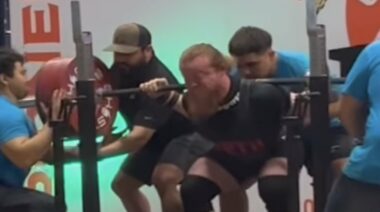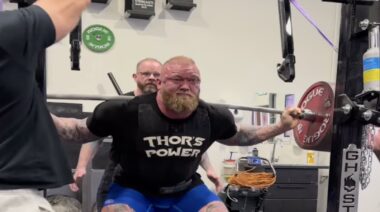The squat is easily the most popularized and important exercise in the gym today, and with good reason. The squat is known for its muscle building, compound mechanics, and difficulty level. But using proper technique and form is crucial for a healthy, injury-free squat experience throughout the maturation of your workout program and regimen.
Keeping squat injuries at bay involves knowing the technicalities of the exercise. Barbell positioning is one area that can be important for strategizing the lift and how best to execute given your goals and your body. Therefore let’s review the barbell positions for some of the more prominent squat exercises done in the gym today.
The Front Squat
The front squat is a variation from the traditional back squat. It is popular particularly in Olympic weightlifting and CrossFit training. When compared to the back squat, you will find your posture more upright in order to maintain the bar over your center of gravity. The weight of the barbell will force your body to lean forward. To prevent this, your chest must be up, open, and supported by the upper back. If you do not keep your chest up, you run the risk of falling forward and dropping the weight.
Below are the two grip styles and some tips to help manage the approach:
Crossed Arm Grip:
This version of the front squat grip makes it a lot more difficult to secure the weight. Place the bar in front of your shoulders, resting it directly on top of your deltoids, just as you with clean grip version. You then will cross your hands over the bar, making an “X” when looked at from up above. Elbows will face forward and arms will be parallel to the ground. Keeping the bar over your heels will help in assisting an upright position. Elbows must also be kept up.
Key takeaway: More difficult to secure the weight and keep elbows up and parallel to the floor. Those with wrist pain can use this version to alleviate those problems. Also, elbows should almost be on a plane with the bar.
Clean Grip:
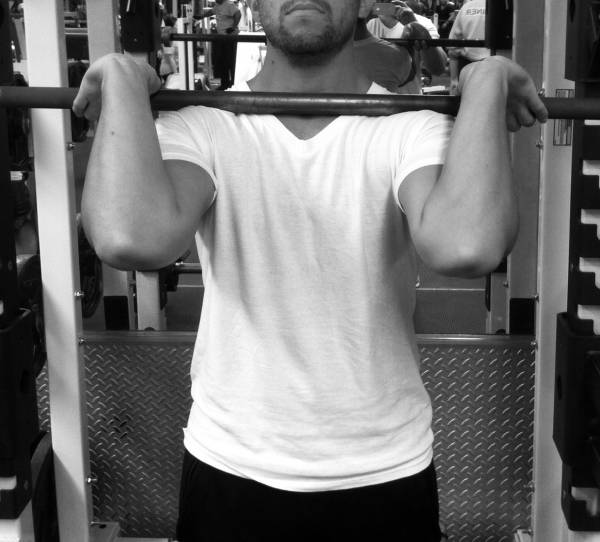 When compared to the crossed arm grip, this grip will be a lot safer and more secure. To get into position the barbell can be cleaned off the floor or approached in a squat rack. The barbell will rest on your shoulders and your fingers will be left underneath the bar, positioned there for stabilization. Your handgrip will be slightly wider than shoulder-width. The key is to not have your hands squeeze the barbell, but rather just securing it.
When compared to the crossed arm grip, this grip will be a lot safer and more secure. To get into position the barbell can be cleaned off the floor or approached in a squat rack. The barbell will rest on your shoulders and your fingers will be left underneath the bar, positioned there for stabilization. Your handgrip will be slightly wider than shoulder-width. The key is to not have your hands squeeze the barbell, but rather just securing it.
Keeping your elbows up will prevent the bar from slipping forward. Aim to keep your elbows parallel to the floor and not flared out, as this will again help you in keeping your torso and upper back straight. The barbell will be spread across and behind your clavicles, lying in front of your front shoulders. Consider the bar nearly choking you.
Key takeaway: Those with tight wrists and triceps will have difficulty performing the clean grip. Aim to stretch the wrist joint and triceps and you will gradually see higher elbow positioning. Pointing your elbows in and not flaring out will be easier on your wrists. In addition, keep in mind that not all fingers need to be wrapped under the bar. Two fingertips on each hand will do just fine. Out of the two variations, the clean grip is the ideal variation of the two simply due to elbow position and locking the weight more effectively.
Pros and Cons of the Front Squat
For lifters who are looking for the ultimate development, recruitment, and size of their quad muscles, the front squat exercise will be it. Due to the barbell position being in front of their body and not on the back, your quads are stressed much more than they would when compared to the back squat. Abdominal targeting is another perk of this version.
Conversely, you will not be able to lift as much weight on your front squat, as you will on your back squat. The upper back helps support the front weight of the bar, the more weight, the more your upper back will have to work to stabilize. In addition, there is minimal stress on your posterior chain muscles.
Back Squat
The main distinction of the back squat over the front squat is evident as the name implies. The barbell lives on your back rather than on the front. The back squat demands and stresses your hamstrings more effectively than the front squat. So those who prefer to increase their deadlift numbers might benefit indirectly from back squats. The positioning of the bar will dictate what mechanics must be used to maintain lifting efficiency.
We will review both the high and low bar positioning:
High Bar Position:
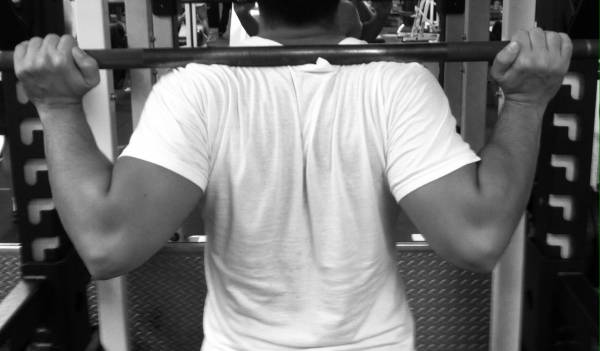 Out of the two back squat bar positions, this variation is commonly used by Olympic weightlifters, which is why it is also dubbed Olympic style. The barbell will sit up on the traps. The pelvis and torso remains slightly more upright compared to a low bar position.
Out of the two back squat bar positions, this variation is commonly used by Olympic weightlifters, which is why it is also dubbed Olympic style. The barbell will sit up on the traps. The pelvis and torso remains slightly more upright compared to a low bar position.
Key takeaway: With the high bar positioning, you can squat deeper, this is because you have a more upright position of your torso – allowing you to drive deeper with your hips. This is well known as the “ass-to-grass” technique, but requires more ankle mobility and might not be appropriate for lifters with limited ankle and hip flexibility.
Low Bar Position:
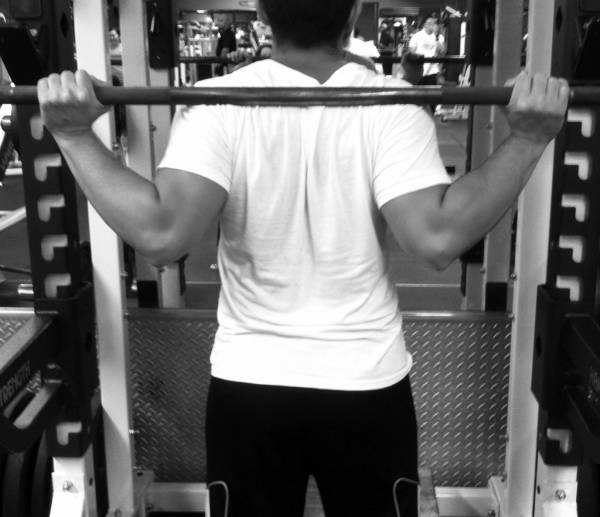 The low bar position gives you better leverage and minimizes back strain mainly because the distance between the point of rotation (your hips) and the bar is smaller, which clearly gives you a mechanical advantage to the high bar squat. In turn, this allows the body to lift more weight. Moreover, you are activating the posterior chain, hips, and lower back more than you would when compared to the high bar position.
The low bar position gives you better leverage and minimizes back strain mainly because the distance between the point of rotation (your hips) and the bar is smaller, which clearly gives you a mechanical advantage to the high bar squat. In turn, this allows the body to lift more weight. Moreover, you are activating the posterior chain, hips, and lower back more than you would when compared to the high bar position.
Key takeaway: Easier on the ankles and the low bar puts a premium on the posterior chain (particularly the hamstrings) for hip drive. Those who want to target more of the posterior chain will find this variation pleasing.
Low Bar Versus High Bar and Your Knees
The low bar squat is far more balanced when it comes to the anterior and posterior forces at the knee because the focus on the hamstring contraction pulls back on the knee. In contrast, the high bar has more of an anterior stress since the quads are the primary movers and attach at the front of the knee at the patella. There is some quadriceps involvement in the low bar squat, but not nearly as much as the high bar squat.
Conclusion
Whether you choose front or back, high or low, crossed or clean, just remember that picking which squat to do is an important question to ask when designing your workouts. Barbell positioning has an impact on which body parts are involved and plays a crucial role in the proper mechanics of a good squat. Each squat has its own nuances and its own strengths. And as with any progressive loading program, as the squats gets heavier, you will sacrifice and compromise your form. So have a training partner around to assess your form and help you out, especially if you are trying a squat that is new for you.
What has worked for you? Do you have a favorite barbell position for the squat? Why?



